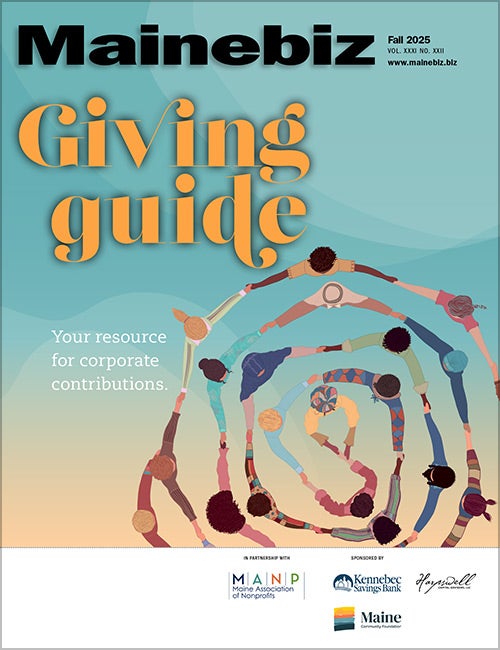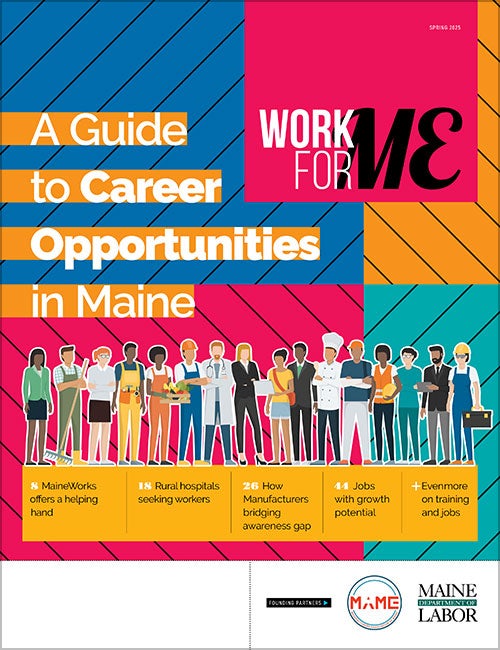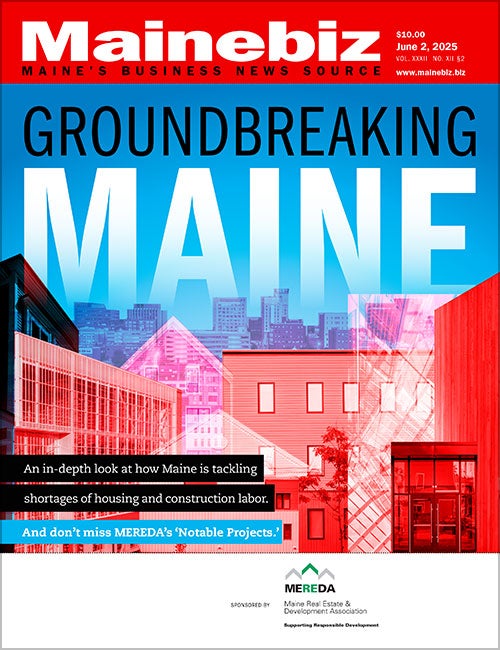Processing Your Payment
Please do not leave this page until complete. This can take a few moments.
- News
-
Editions
View Digital Editions
Biweekly Issues
- December 1, 2025
- Nov. 17, 2025
- November 03, 2025
- October 20, 2025
- October 6, 2025
- September 22, 2025
- + More
Special Editions
- Lists
- Viewpoints
-
Our Events
Event Info
Award Honorees
- Calendar
- Biz Marketplace
Target market | New marketing efforts aim for the lucrative gay and lesbian demographic
Within the last year, the nonprofit agency in Portland has reached out to companies to spark a dialogue about how businesses can both benefit from and help forge a more tolerant community. Maine's economy will only become stronger, says Brian Sandberg, EqualityMaine's development director, if the state can attract talented gay, lesbian, bisexual and transgendered workers and support the ones already here.
"We're going to businesses with a different kind of message," Sandberg says, departing from the organization's previous model of merely asking companies for sponsorships. "We have institutional knowledge, a clearinghouse of information, and we want to use those resources and expertise to help businesses grow."
Research has shown a correlation between a flourishing creative economy, which supports the long-term growth of a region, and an open and diverse community. And more pointedly, Sandberg says, the GLBT consumer not only has considerable buying power, but also tends to be brand loyal. "We want companies to communicate with us about GLBT consumers, recognizing it as a larger movement to make the state a more welcoming place for the GLBT tourist, worker and entrepreneur," he says.
EqualityMaine's work has coincided, too, with a new campaign by the Convention and Visitors Bureau of Greater Portland to lure more GLBT tourists to the city. President Barbara Whitten says the bureau is investing about $10,000 initially to reach out to GLBT travelers by advertising online, working with the Rainbow Business and Professional Association in Portland and reaching out to gay and lesbian travel journalists. "The time is right, and it's the right thing to do," she says. "It's a good niche market for us."
Starting to catch on
Last month, EqualityMaine hosted a talk in Portland by Stephanie Blackwood, co-founder of the New York City advertising firm Double Platinum, who spoke about gay and lesbian marketing and the demographics that have impressed national companies for years.
The gay, lesbian, bisexual and transgendered community sits on $690 billion of spending power in the United States, Blackwood says, a number expected to grow to $835 billion by 2011. They also graduate from college at a higher rate, and their median income of $60,000 is higher than the general population's median income of $57,000, according to her firm's research.
And Blackwood says the percentage of GLBTs who have two-income households is 57%, versus 48% of the general market, and they generally have more discretionary income.
Blackwood wrote in an e-mail after the talk that she suspects the statistics of success coming out of the GLBT community have to do with "self-esteem and wanting to prove ourselves." She also reasons that gays and lesbians tend to migrate to urban centers where they find more acceptance, greater peer networking and higher-paying jobs.
EqualityMaine figures about 52,000 GLBT people live in Maine, based on U.S. Census data and other polls. And between 1990 and 2006, the number of same-sex couples in the United States increased 21 times faster than the general population. GLBT people also were 45% more likely to migrate to New England, perhaps because of the region's more liberal laws around same-sex unions, Blackwood says.
Judy Katzel, president of Burgess Advertising and Marketing in Portland, was convinced enough by Blackwood's lecture to start mentioning the GLBT community as a possible marketing niche during consultations with clients. "We might ask, 'Have you thought about the gay and lesbian community as an option?'" she says.
Lisa Rideout, who oversees an asset management group at Norway Savings Bank, says her financial service has discovered it has been unintentionally attracting many women and lesbian clients. When Rideout mentioned the coincidence to Blackwood, Blackwood says gays and especially lesbians were probably responding to the bank's message of open communication, friendliness and good listening skills.
Following Blackwood's insight, Rideout says she had spoken with the bank's marketing department. "Maybe we were on the right track and we didn't even know we were," she says, adding that the bank won't likely tailor its advertising specifically to the GLBT community, but rather would continue to aim for a broad, inclusive message.
Other banks are already reaching out to the GLBT community. Five County Credit Union, based in Bath, sponsors both EqualityMaine's newsletter and e-mail action alert it sends to its members. "We feel this is a community of people we want to reach out to," says Adam Morris, a marketing specialist with the bank. "Our goal is to reach a diverse membership in general."
National companies began eyeing the GLBT community as early as the 1980s, and stepped up their marketing campaigns in the 1990s, with brands like Absolut Vodka, Subaru and Budweiser gaining notice for their targeted ads. In 1990 Blackwood launched her advertising company to create marketing exclusively for the GLBT community. In Maine, however, there's been less of a direct push. "Some of the companies here in Maine are just catching on," observes EqualityMaine Executive Director Betsy Smith.
Blackwood says her experience has shown that inauthentic messages turn the GLBT consumer off, and so can using straight actors or models. "We can tell the difference between gay and non-gay," she says. Symbols, too, are out, like the faded rainbow, which she called "ho-hum" as a creative solution.
But GLBT-targeted advertising might also be on the decline. The decreasing marginalization of gays and lesbians has led to a "post-gay" period, Blackwood explained. And companies that previously spent resources on influencing the GLBT community are speculating they can reach the same people with more generalized marketing strategies. "It's not great for my business," Blackwood says.
Mainebiz web partners

The Giving Guide
The Giving Guide helps nonprofits have the opportunity to showcase and differentiate their organizations so that businesses better understand how they can contribute to a nonprofit’s mission and work.
Learn More
Work for ME
Work for ME is a workforce development tool to help Maine’s employers target Maine’s emerging workforce. Work for ME highlights each industry, its impact on Maine’s economy, the jobs available to entry-level workers, the training and education needed to get a career started.
Learn More
Groundbreaking Maine
Whether you’re a developer, financer, architect, or industry enthusiast, Groundbreaking Maine is crafted to be your go-to source for valuable insights in Maine’s real estate and construction community.
Learn more-
The Giving Guide
The Giving Guide helps nonprofits have the opportunity to showcase and differentiate their organizations so that businesses better understand how they can contribute to a nonprofit’s mission and work.
-
Work for ME
Work for ME is a workforce development tool to help Maine’s employers target Maine’s emerging workforce. Work for ME highlights each industry, its impact on Maine’s economy, the jobs available to entry-level workers, the training and education needed to get a career started.
-
Groundbreaking Maine
Whether you’re a developer, financer, architect, or industry enthusiast, Groundbreaking Maine is crafted to be your go-to source for valuable insights in Maine’s real estate and construction community.
ABOUT
NEW ENGLAND BUSINESS MEDIA SITES
No articles left
Get access now
In order to use this feature, we need some information from you. You can also login or register for a free account.
By clicking submit you are agreeing to our cookie usage and Privacy Policy
Already have an account? Login
Already have an account? Login
Want to create an account? Register
Get access now
In order to use this feature, we need some information from you. You can also login or register for a free account.
By clicking submit you are agreeing to our cookie usage and Privacy Policy
Already have an account? Login
Already have an account? Login
Want to create an account? Register







Comments